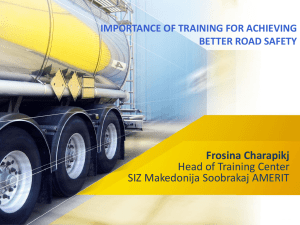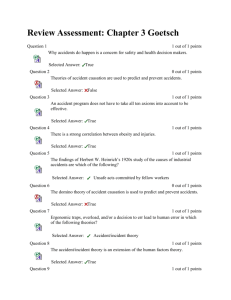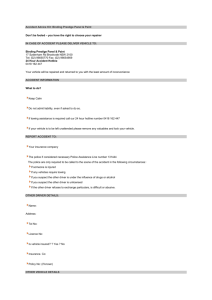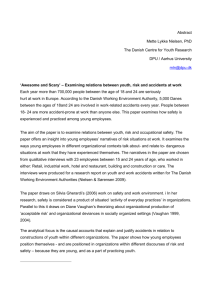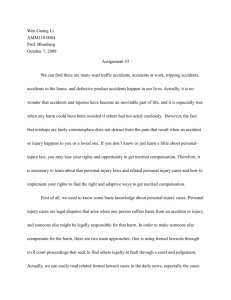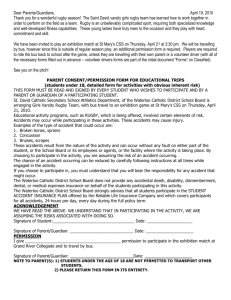ITARDA・Information
advertisement
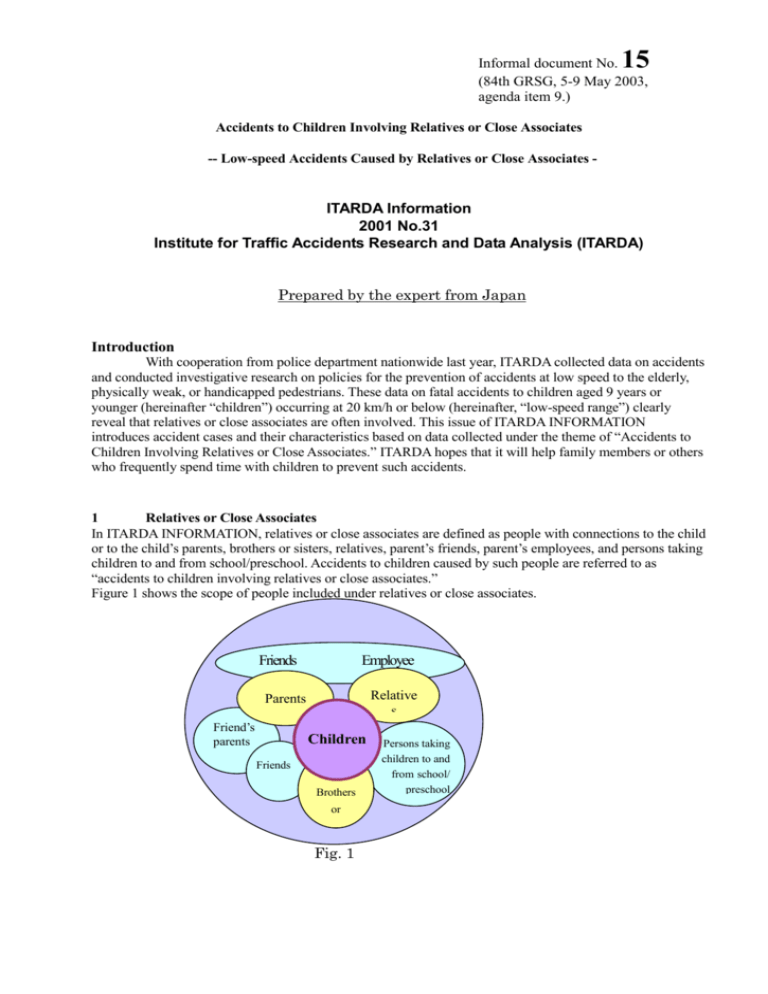
15 Informal document No. (84th GRSG, 5-9 May 2003, agenda item 9.) Accidents to Children Involving Relatives or Close Associates -- Low-speed Accidents Caused by Relatives or Close Associates - ITARDA Information 2001 No.31 Institute for Traffic Accidents Research and Data Analysis (ITARDA) Prepared by the expert from Japan Introduction With cooperation from police department nationwide last year, ITARDA collected data on accidents and conducted investigative research on policies for the prevention of accidents at low speed to the elderly, physically weak, or handicapped pedestrians. These data on fatal accidents to children aged 9 years or younger (hereinafter “children”) occurring at 20 km/h or below (hereinafter, “low-speed range”) clearly reveal that relatives or close associates are often involved. This issue of ITARDA INFORMATION introduces accident cases and their characteristics based on data collected under the theme of “Accidents to Children Involving Relatives or Close Associates.” ITARDA hopes that it will help family members or others who frequently spend time with children to prevent such accidents. 1 Relatives or Close Associates In ITARDA INFORMATION, relatives or close associates are defined as people with connections to the child or to the child’s parents, brothers or sisters, relatives, parent’s friends, parent’s employees, and persons taking children to and from school/preschool. Accidents to children caused by such people are referred to as “accidents to children involving relatives or close associates.” Figure 1 shows the scope of people included under relatives or close associates. Friends Employee Relative s Parents Friend’s parents Children Friends Brothers or sisters Fig. 1 Persons taking children to and from school/ preschool 2 Description of Data Collected Of all fatal accidents occurring at speeds of about 20 km/h or below, data were collected on those satisfying the following conditions. 1) Accident occurred between a four-wheel vehicle and a child pedestrian aged 9 years or younger or an elderly pedestrian aged 65 years or older. 2) Accident of which a major cause was a vehicle’s blind spot or failure by the driver to check adequately for safety. * In order to clarify the conditions under which accidents occurred, those not included in accident statistics, for example, accidents in yards or within household compounds, were also investigated. This analyzed investigation is based on accidents that had been taken place between 1998 and 2000. Total number of cases on which data were collected Accidents involving relatives or close associates Accidents to children 55 18 Accidents to elderly 161 6 Table 1 Number of Accident Cases on Which Data Were Collected 3 Characteristics of Accidents Involving Relatives or Close Associates The characteristics of accidents to children, in the low-speed range involving relatives or close associates, are based on the accident data collected as follows. (1) Percentage of Accidents Involving Relatives or Close Associates From the collected data indicated in Table 1, the percentages of accidents involving relatives or close associates show that there is a higher percentage of accidents to children as opposed to the elderly (Figure 2). Proportion (%) 0% 10% 20% Accidents to elderly 3.7 Accidents to children 30% 40% 50% 60% 70% 80% 90% 100% 96.3 32.7 67.3 Accidents involving relatives or close associates Accidents not involving relatives or close associates Figure 2 Comparison of Percentages of Accidents Involving Relatives or Close Associates (2) Accidents Breakdown by Category of Relatives or Close Associates Looking at the types of people responsible for accidents involving relatives or close associates, among males there are large numbers of fathers and persons taking children to and from school/preschool. Among females, mothers and parents’ friends topped the list (Table 2). Table 2 Number of Accident Cases by Category of Relatives or Close Associates Category of relatives or close Number of cases associates Male Father 6 Person taking children to 3 and from school/preschool Grandfather 1 Female Mother 3 Parent’s friend 3 Person taking children to 1 and from school/preschool Employee 1 Total 18 (3) Number of Accidents Cases by Age of Children Look at the breakdown of accidents by age of children, based on the collected data, among accidents involving relatives or close associates, as opposed to the total number of accidents, former accidents involve infants 1 or 2 years of age (Figure 3). By age Total accident cases Accidents involving relatives or close associates 1 years old 10 7 2 years old 13 6 3-6 years old 22 2 7-9 years old 10 3 Proportion (%) Total accident cases 18.2 Relatives or close associates 40 38.9 0% 1years old 23.6 20% 2years old 33.3 40% 11.1 16.7 60% 3-6 years old 18.2 80% 100% 7-9 years old Figure 3 Accident Breakdown by Age of Children (4) Number of Accidents Cases by Activity of Children The breakdown of accidents by activity of children reveals that many accidents were caused by relatives or close associates while the child was standing still (Figure 4). * “Standing still” means the child is standing for purposes other than playing. Proportion (%) Total accident cases 18.2 34.5 Accidents involving relatives or close associates Standing still 23.6 44.4 Playing 27.8 Crossing at other locations 10.9 11.1 Crossing at the crosswalk 12.7 16.7 Other Figure 4 Accident Breakdown by Accident Type Accident type Total accident cases Standing still 10 Accidents involving relatives or close associates 8 Playing 19 5 Crossing at other 13 2 locations Crossing at the crosswalk 6 Other 7 3 (5) Accidents Breakdown by a Driver’s Sex The breakdown of accidents in total by a driver’s sex shows that a large percentage of accidents involving relatives or close associates are caused by female drivers (Figure 5). Proportion (%) Total accident cases Accidents involving relatives or close associates 78.2 55.6 21.8 SEX 44.4 Male Male Total accident cases Female Female 43 12 Accidents involving relatives or close associates 10 8 Figure 5 Accident Breakdown by Driver’s Sex (6) Accident Breakdown by Action of Drivers Looking at the accidents broken down by action of drivers, among accidents involving relatives or close associates, a large percentage of accidents occurs while the driver is starting to go forward, reversing or making a left turn, among which starting to go forward accounts for a large proportion (Figure 6). Proportion (%) Total accident cases 40 21.8 Accidents involving relatives or close associates 21.8 66.7 Starting to go forward Reversing 10.9 27.8 Turning left Going straight forward Turning right 3.6 1.8 5.6 Other Figure 6 Accident Breakdown by Action of Drivers Type of action Starting forward to Total accident cases Accidents involving relatives or close associates 22 12 12 12 5 1 go Reversing Turning left Going forward straight 6 2 1 Turning right Other (7) Accident Breakdown by Vehicle Configuration The accident breakdown by vehicle configuration shows that mini-van vehicles account for many of the accidents involving relatives or close associates (Figure 7). Among accidents involving relatives or close associates, broken down by driver age, many are caused by female drivers 20 to 30 years of age. In 5 of 7 such cases, the vehicle was a mini-van car. Elsewhere, accidents involving males taking children to and from school/preschool tended to be caused by drivers in their 50s or 60s driving buses or other shuttle vehicles (Table 3). Proportion (%) Total accident cases Accidents involving relatives or close associates Mini-van Small-size bus 29.1 27.3 55.6 Small or medium-size truck Medium or large-size bus 23.6 16.7 Sedan or station wagon Other 7.3 11.1 SUV Figure 7 Accident Breakdown by Vehicle Configuration 5.5 3.6 3.6 11.1 5.6 Vehicle configuration Total accident cases Accidents involving relatives or close associates 16 15 13 4 3 2 2 10 Mini-van Small or medium-size truck Sedan or station wagon SUV Small-size bus Medium or large-size bus Other 3 2 2 1 Table 3 Number of Accident Cases by Vehicle Configuration and Age Group of Relatives or Close Associates Age Breakdown of relatives or close associates 20 S 30 S 40 S Vehicle configuration 50 S 60 S Mini-van Sedarn SUV Small-size Medium bus large-size or bus Male Father 4 1 1 2 Person taking children to and from 2 1 1 2 1 school/preschool 1 Grandfather Mother Female 3 2 Parent’s friend Person taking children to and from 1 3 1 1 2 2 1 1 1 school/preschool Employee 1 1 Note: In the accident statistics, SUVs (Sports Utility Vehicles) are defined as sedan vehicles that exceed 165 cm in vehicle height; small and medium-size trucks are cargo vehicles other than mini-van or light-van vehicles, with a gross weight of 3t to 5t; and other vehicles are based on statistic vehicular configuration of accidents. 4. Occurrence Pattern Among Accidents Involving Relatives or Close Associates In order to clarify how the accidents occurred from the driver’s perspective, the following four issues were investigated for 18 accidents involving relatives or close associates: 1) Was the driver aware beforehand that the child was there? 2) Could the child have been discovered prior to the accident? 3) How did the driver check for safety? 4) Why did the accident occur? The most common pattern of occurrence was found to be as follows: the child’s presence could have been discovered, but the driver did not realize it because he/she did not check for safety, or did not imagine the child was there (Table 4). Table 4 Occurrence Pattern Among Accidents Involving Relatives or Close Associates Was the driver aware beforehand that the child was there? Could the child have been discovered to be there? Did the driver check for safety? Why did the accident occur? Did not Imagine the child was there. No Was possible. Was not aware. Yes Unclear No Direct visual check. Was not aware. Did not Imagine the child was there. Did not Imagine the child was there. Was possible. Could not have discovered the child’s presence. No In a rush. Saw someone else. No. Over-confident about driving conditions. Direct visual check and mirror Did not Imagine the child was there. Was not possible. Unclear No 83% “Was 67% possible.” No No Distracted by cell phone. No Could not have discovered the child’s presence. 78% “Did not imagine the child was there.” 39% 5 Introduction to Accident Cases (1) An accident caused by a father reversing (approximate speed: 10 km/h) The father (27 years old) stopped his sedan at the left side of the road, took up his daughter (3 years old) seated in the passenger seat and placed her outside the vehicle on the driver’s side. Without checking for safety, the driver began to reverse while the driver’s side door was still open. The door knocked the child down and the vehicle run over her house house house . (2) An accident caused by a preschool bus driver (approximate speed: 5 km/h) The driver (57-year-old male) of a preschool bus, upon starting to drive forward with children on the bus, was distracted by mothers and others seeing their children off. He failed to notice that a brother (2 years old) of a child passenger was approaching the bus from the right side of the road, and the behicle run over the child. Victim’s house (3) An accident caused by a primary school bus driver reversing (approximate speed: 10 km/h) The driver (60-year-old male) of a large primary school bus shifted into reverse before picking up children on the school compound who were returning home. Without using a monitor or other device to check for safety, the driver backed up and this vehicle run over a child (8-year-old boy) standing at the left rear of the bus. School yard gymnasium (4) An accident caused by a father starting to go forward (approximate speed: 10 km/h) When the father (28 years old) started to drive his mini-van vehicle forward in the garage, he failed to notice that his daughter (1 year-old) was near the right rear of the vehicle and she was run over by his vehicle. School yard gymnasium (5) An accident caused by a mother reversing (approximate speed: 5 km/h) After removing her son (1 year old) from a sedan, the mother (29 years old) tried to reverse the vehicle into the garage. She failed to check for safety and did not notice that he was near the left rear of the vehicle. Because of this, her child was run over by her vehicle. Victim’s house t. (6) An accident caused by mother’s friend starting to go forward (approximate speed: 5-10 km/h) The friend (32-year-old woman) of the mother visited her home in an SUV, and was talking with her at the roadside. After another vehicle approached from the front, the friend went to move her own vehicle and hurriedly started to go forward without checking for safety. Her vehicle run over the mother’s son (2 years old), who was standing at the left front of her vehicle. house (7) An accident caused by a mother reversing (approximate speed: 5 km/h) As she went to pick up her daughter (1 year old) from her grandmother’s house, the mother (29 years old) started to reverse her mini-van vehicle to be parallel with the entrance to the grandmother’s house. Hearing the noise of the engine, the daughter came out of the house, and was hit by her mother’s vehicle. She was failing to notice that her daughter was at the left rear of the vehicle. house house house Grandmother’s house (8) An accident caused by an employee starting to go forward (approximate speed: 5 km/h) A female employee (41 years old) knew in advance that her manager’s son (1 year old) was at the left rear of her vehicle. Her vehicle had stopped. After reading a document while in the driver’s seat of her mini-van cargo vehicle, she failed to notice that the manager’s son had moved to the front right of her vehicle. The son was run over by it when she had been starting to go forward to drive into the garage. Victim’s house Garage (9) An accident caused by a father starting to go forward (approximate speed: 10 km/h) The father (28 years old) who had just finished shopping with his daughter (5 years old), stepped into his SUV. He thought his daughter had been already in the vehicle, and he started to drive forward. However, she was about to get into the vehicle at the left rear and run over by it. Victim’s house Garage (10) An accident caused by a person who had taken her child to nursery starting to go forward (approximate speed: 5 km/h) The child (1 year old girl) was taken to a nursery together with her sister in her mother’s car. The child followed her mother and her sister after they had left the vehicle. Meanwhile, a woman (26 years old) who had just dropped off her own child at the same nursery, started to drive forward in her mini-van vehicle in order to return home. Her attention was caught by another vehicle backing up from the parking lot, and the car hit the girl, because of lacking of the driver’s notice of her at the front right of her vehicle. Parking lot sister mother Nurser y Mother’s vehicle Field Conclusion Most of accidents involving relatives or close associates occur when vehicles start to move after being stopped, whether going forward or in reverse. Keys to preventing such accidents, for the driver, are to look around the vehicle before getting in to, make sure there are no children near, and then to check thoroughly for safety before starting to drive the vehicle. Furthermore, guardians should make sure that the children in their care are always within view, bearing in mind that children may approach people they know. Drivers taking children to and from school, friends and others who frequently spend time with children should also be made aware of the common causes of accidents. Accidents to children cause deep distress to close family members, who are naturally anxious about their future. Accidents to children involving relatives or close associates can also destroy their deep personal ties, including conjugal or between friends, that may never heal. To prevent such accidents, it is important constantly to look out for the welfare of children and to check for safety.

